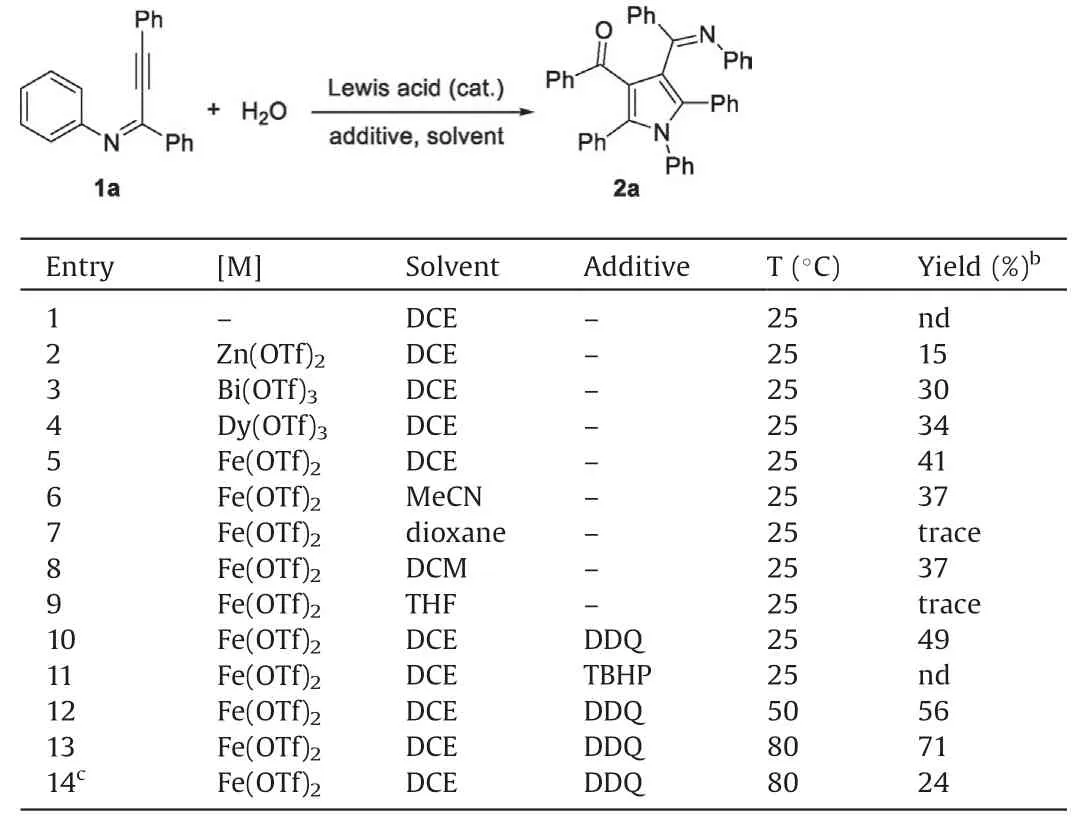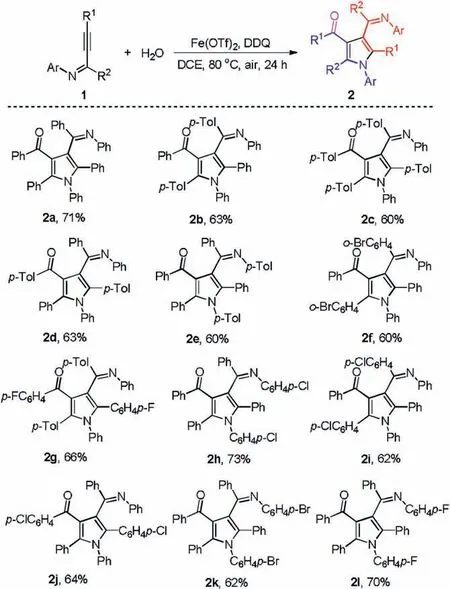An unexpected iron(II)-promoted reaction of N-arylprop-2-yn-1-imines with water: Facile assembly of multi-substituted pyrroles
2021-04-02KidZhouJipinHungJieWuGunyinshengQiu
Kid Zhou,Jipin Hung,Jie Wu,b,*,Gunyinsheng Qiu**
a School of Pharmaceutical and Materials Engineering & Institute for Advanced Studies, Taizhou University, Taizhou 318000, China
b State Key Laboratory of Organometallic Chemistry, Shanghai Institute of Organic Chemistry, Chinese Academy of Sciences, Shanghai 200032, China
c College of Biological, Chemical Science and Engineering, Jiaxing University, Jiaxing 314001, China
ABSTRACT Generation of multi-substituted pyrroles is accomplished through an unexpected iron(II)-promoted reaction of N-arylprop-2-yn-1-imines with water.This transformation proceeds smoothly with excellent chemoselectivity and regioselectivity.A stoichiometric amount of Fe(OTf)2 is necessary for the successful conversion.A Lewis acid-promoted tandem reaction pathway is proposed.
Keywords:Tandem reaction Iron(II) triflate Prop-2-yn-1-imine Pyrrole Water
Due to the importance of sulfonyl-containing pharmaceuticals and natural products, we have continuously focused on the methodology development for the generation of sulfonyl compounds from sulfur dioxide [1].Recently, we designed a reaction with the insertion of sulfur dioxide by using N-arylprop-2-yn-1-imines as the substrates.The studies were initially performed for the reaction of N-arylprop-2-yn-1-imine 1a, 4-methylphenyldiazonium tetrafluoroborate and DABCO ·(SO2)2(Scheme 1).We anticipated that a tandem radical reaction would take place,leading to sulfonyl-containing N-heterocyclic product.However,no desired product was observed for the substrate of N-arylprop-2-yn-1-imine 1a when the reaction was performed in 1,2-dichloroethane(DCE)at room temperature.We reasoned that the presence of Lewis acid might coordinate the nitrogen atom,thus facilitating the transformation.Therefore, a stoichiometric amount of zinc triflate was added in the reaction system.To our delight,a product was obtained and isolated although the yield was low (15%).However, it was found that after structural illustration, sulfur dioxide was not involved during the reaction process.Instead, an unexpected multi-substituted pyrrole 2a was afforded, and the structure was clarified by X-ray analysis(Scheme 1)[2].From this outcome, it seemed that only N-arylprop-2-yn-1-imine 1a and water were participated in the transformation via a tandem process.Additionally, this transformation showed excellent chemoselectivity and regioselectivity, since two molecules of N-arylprop-2-yn-1-imine 1a were involved.
Tandem reaction is well-recognized as a powerful tool towards"molecular skeleton-privileged" architectures [3].Among these established achievements, alkyne-based regioselective addition combined with various annulation has attracted ever-growing interest of chemist due to its high reaction efficiency and transformation versatility[4].For example,radical ipso-cyclization already represented an elegant alternative for the synthesis of heterocyclic compounds [5].On the other hand, it is known that pyrrole is the core structure in numerous bioactive natural products [6].Additionally, there are many pyrrole derivatives showing assorted pharmacological activities such as FPR1 antagonists[7a],antivirals HIV-1[7b],antitumorals[7 7c],or anticancer VEGF-R enzyme inhibitors [7 7d].Thus, continuous efforts have been given to the preparation of pyrrole derivatives[8].As part of our program for the generation natural product-like compounds for diverse biological evaluations [9], we are interested in the method development and library construction of pyrrole derivatives.Thus, we started to explored the feasibility for the generation of multi-substituted pyrroles from the above unexpected reaction of N-arylprop-2-yn-1-imines.

Scheme 1.An unexpected reaction of N-arylprop-2-yn-1-imine 1a.
From the structure of compound 2a,it seemed that the reaction was initiated by the addition of water to N-arylprop-2-yn-1-imine 1a.Thus,to verify the practicality of the above transformation,we started to optimize the reaction of N-arylprop-2-yn-1-imine 1a and water.The results are illustrated in Table 1.At the outset, a blank experiment without any additive was carried out.As a result,no formation of desired product 2a was observed(Table 1,entry 1).In order to facilitate the nucleophilic addition of water to N-arylprop-2-yn-1-imine 1a, several Lewis acids were examined in the reaction.As a consequence, the addition of Zn(OTf)2,Bi(OTf)3, Dy(OTf)3and Fe(OTf)2all provided the desired product 2a (Table 1, entries 2-5).Treated with Fe(OTf)2, the reaction efficiency was improved,leading to the desired product 2a in 41%yield (Table 1, entry 5).Only a trace amount of product could be obtained when Fe(OTf)3or HOTf was used (data not shown in Table 1).The solvent effect indicated that 1,2-dichloroethane(DCE)was the best choice.Other solvents such as MeCN, 1,4-dioxane,DCM, and THF provided inferior results (Table 1, entries 6-9).To further increase the reaction efficiency, other additives such as DDQ and TBHP were also screened.The reaction yield was increased to 49%when DDQ was used as an oxidant(Table 1,entry 10).From the results on temperature evaluation,it seemed that the reaction was sensitive for the reaction temperature.The reaction worked better with the formation of desired product 2a in 56%(Table 1, entry 12) when the reaction was carried out at 50°C.Further examination showed that the desired product 2a could be produced in 71% yield when the reaction was performed at 80°C(Table 1,entry 13).Additionally,the loading amount of Lewis acid was evaluated.It was surprised to find that stoichiometric amount of Fe(OTf)2was requisite.The yield was dramatically reduced when 30 mol% of Fe(OTf)2was employed (Table 1, entry 14).

Table 1 Initial studies for the reaction of N-arylprop-2-yn-1-imine 1a and water.a
With the optimized conditions in hand, we then explored the generality and scope of this iron(II)-promoted reaction of N-arylprop-2-yn-1-imines 1 with water.The results are presented in Scheme 2.A range of multi-substituted pyrrole derivatives were generated accordingly in good yields.From the results, it seemed that electronic effect of the substituents R1made slight impact on the outcome.Screening on the substituent effect of R1and R2indicated that the reactions uniquely worked well when both R1and R2were equal to aryl groups.The reactions of substrates attached with alkyl groups on R1or R2did not offer the corresponding products (data not shown).Moreover, electronic effect of R2did not make significant impact on the reaction yields.For instance, similar yields were observed when 4-methylphenysubstituted and 4-chlorophenyl-connected substrates were used as the starting materials, leading to the corresponding products 2d and 2j in 63% and 64% yields,respectively.Finally,steric effect of the substituent R2was explored.It was found that the substrate with steric group was also compatible in this transformation.For example, reaction of the substrate attached with 2-bromophenyl on R2position worked well to afford the corresponding product 2f in 60% yield.

Scheme 2.Scope exploration for the iron(II)-promoted reaction of N-arylprop-2-yn-1-imines 1 with water.Isolated yields based on N-arylprop-2-yn-1-imine 1.

Scheme 3.Plausible mechanism.
To explore the mechanism of the reaction,we investigated the reaction of N-arylprop-2-yn-1-imine 1a and water in the presence of 2.0 equiv.of 2,2,6,6-tetramethyl-1-piperidinyloxy (TEMPO)under the optimized conditions.As expected, the reaction was hampered.On the basis of the above results, a plausible mechanism is proposed, which is shown in Scheme 3.We reasoned that assisted with stoichiometric amount of Fe(OTf)2,nucleophilic addition of water to N-arylprop-2-yn-1-imine 1 would provide enamine intermediate A quickly and efficiently.Sequential aza-Michael-type addition of intermediate A to Narylprop-2-yn-1-imine 1 would afford an anion intermediate B.In the presence of an oxidant (DDQ), the intermediate B would be oxidized into a radical intermediate C via a single electron transfer(SET).Subsequently, intramolecular radical ortho-cyclization would occur giving rise to intermediate D, which would undergo deprotonation leading to the desired product pyrrole 2.
Inconclusion,we have described anunexpected iron(II)-promoted reaction of N-arylprop-2-yn-1-imines with water,leading to multisubstituted pyrroles in good yields.This transformation proceeds smoothly with excellent chemoselectivity and regioselectivity.A stoichiometric amount of Fe(OTf)2is necessary for the successful conversion.A Lewis acid-promoted tandem reaction pathway is proposed.
Declaration of competing interest
The authors declare that they have no known competing financial interests or personal relationships that could have appeared to influence the work reported in this paper.
Acknowledgments
Financial support from the National Natural Science Foundation of China(Nos.21871053 and 21532001)and the Leading Innovative and Entrepreneur Team Introduction Program of Zhejiang (No.2019R01005) is gratefully acknowledged.
杂志排行
Chinese Chemical Letters的其它文章
- A biomass based photonic crystal made of “konjac tofu”
- Hydrothermal-assisted grinding route for WS2 quantum dots (QDs)from nanosheets with preferable tribological performance
- Superiority of poly(L-lactic acid) microspheres as dermal fillers
- Zwitterionic comb-like lipid polymers encapsulating linalool for increasing the fragrance retention time
- Construction of a nano-rectangular Zn-Nd complex with near-infrared luminescent response towards metal ions
- Synthesis and structure of Au19Ag4(S-Adm)15 nanocluster:Polymorphs and optical properties
